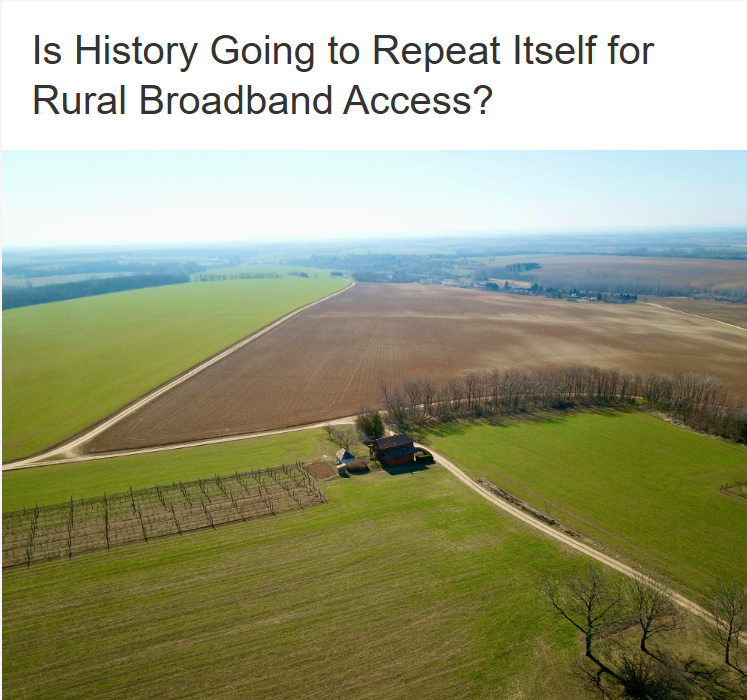Is History Going to Repeat Itself for Rural Broadband Access?
March 28, 2025
In 2010, the FCC produced the National Broadband Plan (NBP), a “comprehensive” roadmap with scores of policy recommendations to ensure every American would have access to broadband.
- The NBP became the basis of the FCC’s reforms to its universal service programs.
- In the decade that followed, nothing was more damaging to rural broadband service than the National Broadband Plan.
What does the National Broadband Plan have to do with BEAD?
With BEAD, the Trump Administration is at risk of repeating the mistakes of the Obama Administration.
Historical Context

The NBP’s goal was to ensure that by 2020, 100 million urban/suburban homes would have access to 100 Mbps downstream internet service (colloquially called “100 squared”).
In 2010, there were 116 million households in the U.S. – approximately 100 million urban/suburban households and 16 million rural households. The NBP 100 squared goal was only for urban/suburban America; the NBP’s goal for rural America was substantially lower – 4 Mbps downstream/1 Mbps upstream (or 4/1 Mbps).
Three points of note regarding the 2010 landscape when the NBP was published:
- Cable broadband was already available to 100 million urban/suburban households, and cable providers were rolling out DOCSIS 3.0 – a new standard that delivered 100 Mbps downstream without any government involvement.
- The FCC budgeted $45 billion over 10 years to achieve the rural 4/1 Mbps standard through its Universal Service High-Cost Fund. The FCC then began spending tens of billions on subsidies to incumbent telecommunications companies using 4/1 Mbps — as opposed to 100 Mbps downstream — as the baseline standard.
- 4/1 Mbps as a standard for rural America was already two generations behind when it was adopted; it was three generations behind by the time the money was spent.
Fast-forward 10 years to 2020, when COVID hit: Rural American households, lacking access to 100 Mbps, were dramatically unprepared to work from home, attend school online, and participate in the economy.
- You can trace the unpreparedness directly back to the NBP’s goals for rural Americans.
The bottom line:
With BEAD, there is a risk history will repeat itself, particularly if the term “technological neutrality” is used to justify substandard service for rural America.
- The 100/20 Mbps BEAD standard already is two generations behind.
- By the time BEAD money is spent, 100/20 Mbps will be three generations behind.
3 BEAD Improvements to Consider

Yesterday, the Senate Commerce Committee held a confirmation hearing for the new NTIA Administrator, Arielle Roth.
My recommendations for Nominee Roth:
I would propose three specific improvements to BEAD for the new NTIA Administrator to consider.
1) The 100/20 Mbps standard should be a minimum standard; and it should be used only if there are no better long-term alternatives.
- BEAD is a long-term investment in rural America.
- There should be a future-proof standard for BEAD that includes any technology capable today of delivering multi-Gigabit performance that will seamlessly evolve over time.
- For any geographic area, if BEAD funding can leverage the construction of future-proof networks such as those already available in urban/suburban areas, that is the right investment in rural America, too.
2) Eliminate rules or regulations that add cost or time to the deployment of rural networks.
- NTIA should reject state programs that adopt climate change resiliency plans, environmental studies, Davis Bacon labor requirements and other costly and time-consuming regulations.
- Redoing a state application process may delay some states on the front end, but it will save considerable time in the long run.
3) Local input should not only be considered; it should be dispositive.
- In my experience, the ones who truly care about getting broadband decisions right are the people affected by decisions, i.e., local officials.
- I would give county councils a leading role in the decisions about how BEAD is spent in their counties, including giving county councils a veto on awards to sub-grantees.
- If county officials do not approve a plan for their county, they should be given the proportionate BEAD allocation for their county to get the job done themselves.
In the coming weeks, I will lay out more specific details about each of these suggestions. I would welcome any ideas you might care to share.
